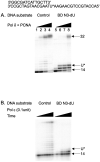Synthesis and mutagenesis of the butadiene-derived N3 2'-deoxyuridine adducts
- PMID: 16841966
- PMCID: PMC2526974
- DOI: 10.1021/tx060016o
Synthesis and mutagenesis of the butadiene-derived N3 2'-deoxyuridine adducts
Abstract
1,3-Butadiene is a known carcinogen and mutagen that acts through a variety of metabolic intermediates that react with DNA, forming stable and unstable lesions on dG, dA, dC, and dT. The N3 2'-deoxyuridine adducts are a highly stable, stereoisomeric mixture of adducts derived from the reaction of cytosine with the monoepoxide metabolite of butadiene, followed by spontaneous deamination. In this study, the phosphoramidites and subsequent oligodeoxynucleotides containing the N3 2'-deoxyuridine adducts have been constructed and characterized. Using a single-stranded shuttle vector DNA, the mutagenic potential of these adducts has been tested following replication in mammalian cells. Replication past the N3 2'-deoxyuridine adducts was found to be highly mutagenic with an overall mutation yield of approximately 97%. The major mutations that were observed were C to T transitions and C to A transversions. In vitro, these adducts posed a complete block to both the Klenow fragment of Escherichia coli polymerase I and polymerase epsilon, while these lesions significantly blocked polymerase delta. These data suggested a possible involvement of bypass polymerases in the in vivo replication of these lesions. Overall, these findings indicate that the N3 2'-deoxyuridine adducts are highly mutagenic lesions that may contribute to butadiene-mediated carcinogenesis.
Figures








Similar articles
-
Mutagenic bypass of the butadiene-derived 2'-deoxyuridine adducts by polymerases eta and zeta.Mutat Res. 2007 Dec 1;625(1-2):40-9. doi: 10.1016/j.mrfmmm.2007.05.003. Epub 2007 May 18. Mutat Res. 2007. PMID: 17586533 Free PMC article.
-
Mutagenic spectrum of butadiene-derived N1-deoxyinosine adducts and N6,N6-deoxyadenosine intrastrand cross-links in mammalian cells.Chem Res Toxicol. 2002 Dec;15(12):1572-80. doi: 10.1021/tx025591g. Chem Res Toxicol. 2002. PMID: 12482239
-
Chemical modification of deoxycytidine at different sites yields adducts of different stabilities: characterization of N3- and O2-deoxycytidine and N3-deoxyuridine adducts of butadiene monoxide.Arch Biochem Biophys. 1997 Jul 1;343(1):63-72. doi: 10.1006/abbi.1997.0164. Arch Biochem Biophys. 1997. PMID: 9210647
-
The role of mutagenic metal ions in mediating in vitro mispairing by alkylpyrimidines.Environ Health Perspect. 1994 Sep;102 Suppl 3(Suppl 3):81-90. doi: 10.1289/ehp.94102s381. Environ Health Perspect. 1994. PMID: 7843141 Free PMC article. Review.
-
Cyclic adducts and intermediates induced by simple epoxides.IARC Sci Publ. 1999;(150):123-35. IARC Sci Publ. 1999. PMID: 10626214 Review.
Cited by
-
Conjugation of butadiene diepoxide with glutathione yields DNA adducts in vitro and in vivo.Chem Res Toxicol. 2012 Mar 19;25(3):706-12. doi: 10.1021/tx200471x. Epub 2012 Jan 9. Chem Res Toxicol. 2012. PMID: 22181695 Free PMC article.
-
In vivo roles of conjugation with glutathione and O6-alkylguanine DNA-alkyltransferase in the mutagenicity of the bis-electrophiles 1,2-dibromoethane and 1,2,3,4-diepoxybutane in mice.Chem Res Toxicol. 2013 Nov 18;26(11):1765-74. doi: 10.1021/tx4003534. Epub 2013 Nov 6. Chem Res Toxicol. 2013. PMID: 24191644 Free PMC article.
-
Mutagenicity of a glutathione conjugate of butadiene diepoxide.Chem Res Toxicol. 2010 Oct 18;23(10):1544-6. doi: 10.1021/tx100304f. Epub 2010 Sep 29. Chem Res Toxicol. 2010. PMID: 20879737 Free PMC article.
-
Identification of 4-(3-Pyridyl)-4-oxobutyl-2'-deoxycytidine Adducts Formed in the Reaction of DNA with 4-(Acetoxymethylnitrosamino)-1-(3-pyridyl)-1-butanone: A Chemically Activated Form of Tobacco-Specific Carcinogens.ACS Omega. 2017 Mar 31;2(3):1180-1190. doi: 10.1021/acsomega.7b00072. Epub 2017 Mar 28. ACS Omega. 2017. PMID: 28393135 Free PMC article.
-
Molecular basis of aflatoxin-induced mutagenesis-role of the aflatoxin B1-formamidopyrimidine adduct.Carcinogenesis. 2014 Jul;35(7):1461-8. doi: 10.1093/carcin/bgu003. Epub 2014 Jan 7. Carcinogenesis. 2014. PMID: 24398669 Free PMC article.
References
-
- Brunnemann KD, Kagan MR, Cox JE, Hoffmann D. Analysis of 1,3-butadiene and other selected gas-phase components in cigarette mainstream and sidestream smoke by gas chromatography-mass selective detection. Carcinogenesis. 1990;11:1863–1868. - PubMed
-
- Pelz N, Dempster NM, Shore PR. Analysis of low molecular weight hydrocarbons including 1,3-butadiene in engine exhaust gases using an aluminum oxide porous-layer open-tubular fused-silica column. J. Chromatogr. Sci. 1990;28:230–235. - PubMed
-
- Owen PE, Glaister JR, Gaunt IF, Pullinger DH. Inhalation toxicity studies with 1,3-butadiene. 3. Two year toxicity/carcinogenicity study in rats. Am. Ind. Hyg. Assoc. J. 1987;48:407–413. - PubMed
-
- Melnick RL, Huff J, Chou BJ, Miller RA. Carcinogenicity of 1,3-butadiene in C57BL/6 × C3H F1 mice at low exposure concentrations. Cancer Res. 1990;50:6592–6599. - PubMed
-
- Zhuang SM, Cochran C, Goodrow T, Wiseman RW, Soderkvist P. Genetic alterations of p53 and ras genes in 1,3-butadiene- and 2′, 3′-dideoxycytidine-induced lymphomas. Cancer Res. 1997;57:2710–2714. - PubMed
Publication types
MeSH terms
Substances
Grants and funding
LinkOut - more resources
Full Text Sources
Other Literature Sources
Miscellaneous

